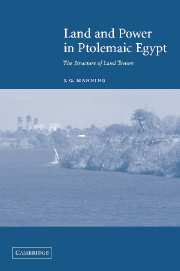Book contents
- Frontmatter
- Contents
- List of maps, figures and tables
- Preface
- Abbreviations
- Units of measure
- Maps
- Part I ISSUES AND HISTORICAL BACKGROUND
- Part II REGIONAL CASE STUDIES OF LAND TENURE
- Part III INTERPRETATION
- Chapter 5 The Ptolemaic state, the land tenure regime, and economic power
- Chapter 6 The private transmission of land
- Chapter 7 Conclusions
- Appendix 1 Translation of the Edfu donation text
- Appendix 2 Ptolemaic demotic land transfers from Upper Egypt
- Appendix 3 Translation of P. Amh. gr. 49
- List of references
- Index of sources
- General index
Chapter 5 - The Ptolemaic state, the land tenure regime, and economic power
Published online by Cambridge University Press: 22 September 2009
- Frontmatter
- Contents
- List of maps, figures and tables
- Preface
- Abbreviations
- Units of measure
- Maps
- Part I ISSUES AND HISTORICAL BACKGROUND
- Part II REGIONAL CASE STUDIES OF LAND TENURE
- Part III INTERPRETATION
- Chapter 5 The Ptolemaic state, the land tenure regime, and economic power
- Chapter 6 The private transmission of land
- Chapter 7 Conclusions
- Appendix 1 Translation of the Edfu donation text
- Appendix 2 Ptolemaic demotic land transfers from Upper Egypt
- Appendix 3 Translation of P. Amh. gr. 49
- List of references
- Index of sources
- General index
Summary
You must regard it as one of your most indispensable duties to see that the nome be sown with the kind of crops prescribed by the sowing schedule.
Instructions of the Dioikêtês to an Oikonomos, preserved in P. Tebt 703, 57–60. Trans. Bagnall and Derow 1981: 135We offer (the properties) for sale on the following terms. The successful bidders shall pay annually to the Crown in the case of the vineyards the proper money taxes and the apomoira….. and for arable land the rents in kind which have been imposed upon it….
P. Eleph. 14 (Edfu, ca. 223 bce) Trans. Select Papyri, vol. II, text 233.In this Chapter I will be concerned with the “reach of the state,” and its ability to control land tenure and the surplus agricultural production. The traditional power of the ruler in Egypt with respect to these issues was asserted in assigning rights to land and in taxing production (and on some land collecting rent). The Ptolemies retained these traditional powers over the land. I begin with a discussion of the structure of the state itself, and the organization of social power within the state. From there, I move on to discuss more specifically one aspect of social power, economic power, and the relationship between state economic power and land tenure.
- Type
- Chapter
- Information
- Land and Power in Ptolemaic EgyptThe Structure of Land Tenure, pp. 129 - 181Publisher: Cambridge University PressPrint publication year: 2003
- 1
- Cited by



